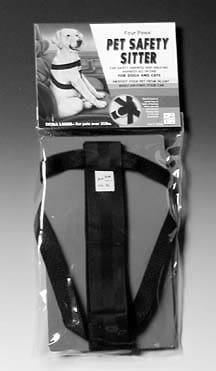There are seat belt laws in most states now, and young children are legally required to be restrained in safety seats in cars in all states. But nowhere is there a law requiring dogs to be safely contained in vehicles.
Those that do only address restraint for dogs in the back of open pick-up trucks. (And even when dogs are safely restrained in the back of a truck, the potential for the dog to be severely injured in an accident is great. The risk of damage to eyes from flying debris, the discomfort from exposure to the elements, and the encouragement of aggressive dog behavior, and the real possibility of jumping or falling from trucks are other good reasons not to allow your dog to ride in the back of trucks.)
We do believe, however, that dogs inside vehicles should be restrained, for their own safety as well as that of other passengers. Unrestrained, an excited or frightened dog can interfere with your driving, causing a serious accident. But even the best-behaved dogs can be violently thrown into the seat in front of them, or, worse, into or through the windshield in an accident.

If dog and passengers survive impact, a panicky dog can escape through broken car windows and become an instant traffic hazard. In fact, my brother lost his Australian shepherd in an accident when, panicked in the confusion, she leaped through a shattered windshield and was struck and killed by an oncoming car.
Crating is one solution, but many cars are too small to accommodate a portable kennel. A reasonable alternative is a restraint system that holds your dog securely in place. There are two basic types: the canine safety harness, and the canine car seat.
Please note: All these systems utilize car seat belts. In many of today’s cars, the front seat belts (and some rear belts) only tighten on impact; during normal travel they expand to allow for passenger comfort. In order to securely fasten any canine restraint system, you may have to use a rear, solid belt or come up with an alternate strap around the front seat to provide a stable base for the attachment. Unless you are mechanically proficient, we would recommend having a solid seat belt installed by a professional.
There are at least a half-dozen different brands of canine safety harnesses on the market. Each consists of a body harness that attaches to the car seat belt. Important criteria to consider are: strength and durability of straps and hardware, comfort, cost, and ease of use. WDJ tested three brands of canine car safety harnesses.
Safety Harnesses
WDJ Recommends
Four Paws’ Pet Safety Sitter:
This is WDJ’s top choice of the restraint products we reviewed. It is well made, with strong, soft, double-stitched nylon and sturdy hardware. The instructions are clear and well-illustrated, and the harness is relatively easy to use.
Best of all, our test dog found it comfortable, and liked the amount of freedom that it provided her in the car. An added feature is the sturdy metal ring stitched into the back of the harness that you can clip a leash to so it doubles as a walking harness.
The Pet Safety Sitter is available for about $12 through pet stores, or from Four Paws Products, Ltd. in Hauppage, NY; (516) 434-1100.
Guardian Pet Specialties’
Pet Safe-T-Belt
For reasons detailed below, this product is our second pick.
The most expensive of the three harnesses we tested, the Pet Safe-T-Belt is also the sturdiest. Consisting of a body harness, frame attachment, and front seat strap, it comes in four sizes and ranges in price from $29.95 for toy dogs (3-7 lbs.), to $44.95 for large breeds (51-100 lbs.). It is completely adjustable, and made of strong, soft nylon, with stitching and fasteners on the outside, away from contact with the pet, to minimize rubbing. It is a bit complicated to assemble and install.
While exceptionally secure, the dual-sided-restraint design caused our test dog some anxiety by unduly restricting her movement. This is a good choice for owners who want a high-end sturdy product and are willing to help their dogs adjust to the high level of restraint that it offers.
The Pet Safe-T-Belt can be ordered from Guardian Pet Specialties, (709) 745-3308.
Not Recommended
Top Paws’ Safe N-Go
In stark contrast to the Pet Safe-T-Belt, this harness is obviously a low-end product. The nylon is narrow, stiff, and the plastic snaps and metal hardware are cheap. The packaging doesn’t indicate which size harness is contained inside, and the instructions for use are cryptic, ungrammatical and hard to follow. The Safe N-Go is available for around $12 at pet stores, but don’t look too hard – WDJ gives it an emphatic “paws down.”
———-
Canine Car Seats
The selection among canine car seats is limited at best. We evaluated three, the largest of which could only accommodate dogs up to 30 pounds. All three retail in the $50 range. For small dogs the car seat can provide an effective restraint system, but it is not an option for larger dogs.
WDJ Recommends
The Dog-Gone Device:
If car safety for your dog is your main concern, we recommend the Four Paws Pet Safety Sitter, mentioned above. However, if you have a small dog (20 pounds or less), and like to carry your dog as much as drive him or her around, this carrier is for you.
The Dog-Gone is primarily a backpack-style animal carrier that doubles as a car seat. Its adjustable mesh fabric pouch is attached to a lightweight frame. Four restraint loops hold the dog’s collar as the dog sits in an upright position, and an extending leg allows the device to stand on its own – that is, as long as the dog is sitting still.
No installation is required; the carrier is simply placed on the seat of the car and strapped in by the seat belt around it. A seat belt that stays tight is mandatory to keep the carrier from tipping over when you brake. The Dog-Gone Device might be a kick for owners who want to take their little dogs with them for errands or other short trips, but don’t want to travel at a little dog’s pace. Hiking, biking or shopping, your canine companion can watch the world go by from her perch on your back.
But as a car seat only, it leaves room for improvement. The dog is held upright and can’t lie down. We would only recommend it as a car seat for short trips. Any dog would find it too confining for longer drives. The Dog-Gone Device retails for $59.95. An optional head cover for shade is $14.95. Both can be obtained from Sanjo, Inc., Pet Products in Las Vegas, at (800) 367-7303.
Not Recommended
Foster & Smith’s ComfortRide Pet Seat
The ComfortRide is a flat, molded plastic, padded seat frame that attaches to the car seat belt. Nylon straps attached to the sturdy frame clip to the dog’s collar. It is compact, lightweight, easy to install, and will hold dogs up to 30 pounds. At $49.99, it has the lowest retail price of the three. Although it is well-made and able to accommodate larger dogs, the ComfortRide Pet Seat relies on restraint via the dog’s collar, which could result in serious damage to the dog’s neck in an accident.
Other Products
We found several other products that were essentially modified leashes, intended to be used with a dog’s usual harness or collar. Please note: WDJ does not recommend attaching a vehicle restraint strap to your dog’s collar as the primary means of restraint.
Although this would work to keep him contained during normal travel, in an accident the force of impact could damage the dog’s trachea, injure the spine, perhaps even break his neck. For just a few dollars more you can purchase the Pet Safety Sitter, and know that your dog is safely and securely restrained in your car.
-By Pat Miller
Pat Miller is a dog trainer and freelance writer from Salinas, CA.






How can I use a car set.??